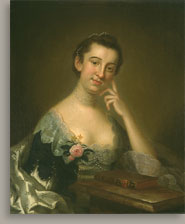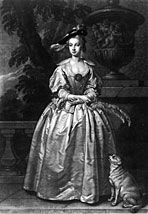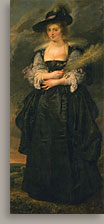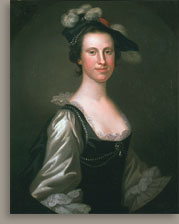 John Wollaston John WollastonAnn Gibbes (Mrs. Edward Thomas) , 1767 Description Ann Gibbes’s brown hair is pulled into a bun atop her head. She wears an earring in her left ear. From a distance, the earring appears to be a shimmering, glasslike stone, but closer examination reveals daubs of yellow, gray, and red paint. A ground layer of paint has disappeared, exposing the ear beneath part of the earring. Her smiling gray-brown eyes are directed at the viewer. Both the iris and the large pupils are oval. A small dot of opaque white paint is placed in the upper left of each pupil. Her eyebrows are dark brown, and some gray paint appears beneath them. In the left corner of her right eye there is a daub of pink paint. The bottom edges of her eyelids are lined with brown paint, suggesting lashes. In the crease of each eyelid are thin, brown-painted shadows. A gray underpaint contributes to the coolness of the flesh tones; this is offset by a hint of pink in the cheeks. A loosely painted white highlight runs the length of the nose. The lips are full, pink, and turned slightly upward at the corners. She wears a low-cut, rose-colored dress, cinched at the waist with a sash of the same color and ornamented with large pear-shaped pearls and strands of round pearls looped over the bodice; the latter pearls are grayish but dotted with opaque white highlights. A pin with one pear-shaped and three round pearls holds up the voluminous proper right sleeve. Lighter pink highlights denote the shadows and folds in the dress. An ermine stole is draped over her shoulders. Wollaston has successfully rendered the fur with numerous short strokes of cream-colored paint followed by longer, thinner, and looser strokes of black. The floral-patterned lace sewn on her shift along the bodice and sleeves is less detailed on the proper left sleeve. The sitter also wears a pair of lace collars. Set between the larger and smaller collar is a strand of pearls, above which appears to be a second strand of pearls surrounding a diamond or glass setting. Ann Gibbes’s arms are crossed and rest on a marble tabletop, rendered in loose brushstrokes of black, brown, and red. The wooden frame of the table is visible beneath the marble top. The young woman holds a black mask between her right thumb and second finger. Biography William Gibbes was an attorney who became a merchant and a planter. In the early 1760s, he moved from Christ Church Parish to Charleston. He owned two schooners and was part owner of two trading vessels. Gibbes also owned a long wharf on the Ashley River, where he later built a Georgian-style mansion, and a plantation with sixty-eight slaves. He belonged to the Charleston Library Society from 1750 until 1787 and to the South Carolina Society, a benevolent organization, from 1752 until his death. In 1766 he served as master of the Master’s Masonic Lodge of Charleston. Gibbes was a member of the first vestry of St. Michael Parish in 1761–62, served as church warden from 1762 to 1764, and as a vestryman from 1764 to 1766, 1777–80, and 1783–85.4 It is very likely that Ann Gibbes married Edward Thomas in St. Michael’s Episcopal Church.5 Shortly after the wedding, her father was elected to the House of Representatives for the Twenty-ninth Royal Assembly and was reelected to terms in the remaining four royal assemblies, the First and Second Provincial Congresses, and the First and Second General Assemblies. He also served in the Senate during the Third General Assembly. During the Revolution, he supported the American cause, loaning South Carolina more than 250,000 pounds. When the British captured Charleston in May 1780, the Gibbeses were evicted from their house and their plantation commandeered.6 Ann’s husband, Edward Thomas (1744–1807), was the son of Samuel Thomas II (1719–1772) and his first wife, Mary Child (1724–1745); they had married in 1740.7 Edward owned North Hampton plantation, which straddled the parishes of St. Thomas and St. Dennis; consisting of some three thousand acres, it was worked by more than one hundred slaves. From 1775 to 1783, he was an officer in the South Carolina Militia. He was elected to the House of Representatives for the Third General Assembly (1779–80). Although he was reelected twice, he did not serve. Edward Thomas also held many local offices, including justice of the peace for Charleston District in 1774 and 1776 and, in 1784, tax inquirer, assessor, and collector for the parishes of St. Thomas and St. Dennis. He was a member of the St. Thomas Hunting Club.8 Ann and Edward had six children: Edward (d. 1769), Elizabeth (1770–1824), Mary (1771–1806), Edward Gibbes (1774–1836), William (1777–1778), and Samuel (1779–1812).9 Ann Gibbes Thomas died on February 13 or 21, 1781, in St. Thomas Parish; she was twenty-nine.10 Six years later, Edward married Elizabeth Burrington (d. 1806).11 Analysis The earliest record of Wollaston’s presence in Charleston is a September 27, 1765, entry in the diary of Ann Ashby Manigault (1705–1782)–wife of the wealthy planter and merchant Gabriel Manigault (1704–1781)–noting that the artist had been her guest at dinner that night.15 He stayed in the Charleston area nearly two years. In February 1767, as he was preparing to leave, he declared his plans in the South Carolina Gazette:
On April 12, six weeks before Wollaston departed, the Manigaults invited him to dinner one last time.17
Wollaston’s rendering of lace in the Ann Gibbes portait was generalized–not specific to the sitter. The lace patterns here, as in the likeness of Rebecca Bee Holmes, do not reflect real types but are instead stylized versions of European bobbin lace. In actual bobbin lace of the time, there was less empty space between the motifs.22 In the 1740s, when the artist was working in England, the practice of depicting sitters clad in imaginary dress was very popular; he did just this in Ann Gibbes (Mrs. Edward Thomas).23 The funnel-shaped sleeve fastened with the pearl ornament in the Ann Gibbes portrait was borrowed from seventeenth-century costumes and would not have been worn in eighteenth-century Charleston.24 The only occasion on which a woman might in fact don such an antiquated costume was at a masquerade ball. Wollaston was probably aware of these choices of costume through mezzotints, to which he often referred for poses.25 For instance, the folded arms and hands in the Ann Gibbes portrait might be derived from Thomas Hudson’s Miss Hudson (n.d., unlocated), which was engraved by John Faber, Jr. (fig. 2).26 And Miss Hudson was itself hardly an original work; Hudson had based it on Helena Fourment (fig. 3), Peter Paul Rubens’s depiction of his second wife. Indeed, from the 1720s to the 1760s a number of British artists used the Rubens image as a source. The costume Fourment wears also was a widely copied choice for British masquerades.27 Wollaston borrowed Fourment’s hat, with its brim fastened up at one side and plumed feathers, and her black open-sleeved gown, with its pearls and lace at the neck, for his Philadelphia portrait Dorothy Willing (Mrs. Walter Stirling) (fig. 4).
It appears clear that Wollaston included the masquerade mask and ermine in Ann Gibbes (Mrs. Edward Thomas) to associate the sitter with fashionable British trends in both portraiture and attire. Although the British sitter in Thomas Hudson’s Gertrude Leveson-Gower, Duchess of Bedford (n.d., Collection of the Duke of Bedford, Woburn) could have attended a ball and worn a mask similar to the one she holds, Ann Gibbes could not.30 There is no evidence that masquerade balls were held in colonial Charleston during the eighteenth century, this despite the fact that such balls then were popular in England.31 However, beginning in 1740s, public balls were held in Charleston to celebrate events such as royal birthdays and accessions, the appointment of new colonial officials, and military victories.32 Private balls, too, were held. For instance, in December 1766, not long before Ann Gibbes posed for Wollaston, Ann Ashby Manigault recorded in her diary that she had attended "Mr. Pikes ball." She made no mention, however, of having worn a masquerade costume.33 Notes 2. Constantina was born on July 24, 1749, and died on September 27, 1751. See Holmes, 1911, 84. 3. William and Mary had two other children between the births of Henry and Catherine; both died before their second birthday. Culcheth was born on January 2, 1766, and died on August 23, 1767. John was born on February 23, 1767, and died on September 3 of that year. See Quinn 1991, I, 18. 4. South Carolina Senate 1986, I, 562–63. William Gibbes’s mansion at 64 South Battery, Charleston, was built in 1772; it faced the Ashley River and his 300-foot-long wharf. The house remains standing. See Rogers 1969, 69; Poston 1997, 276–78; and Chamberlain 1956, 96–103. 5. Unfortunately, the church’s early records were destroyed during the Civil War. 6. South Carolina House of Representatives 1974, II, 274–76. William Gibbes was buried in St. Philip’s Churchyard in Charleston. See Quinn 1991, I, 18. For his will, see Charleston County Wills, vol. 22, 389–91, South Carolina Department of Archives and History, Columbia. An inventory was taken of Gibbes’s estate; see Charleston County Inventories, vol. B, 1787–93, 238–42, South Carolina Department of Archives and History, Columbia. 7. Thomas 1964, 4. 8. South Carolina House of Representatives 1981, III, 707–8. Edward Thomas sold North Hampton to Lewis Foagartie in December 1794. See Smith 1917, 17. After that, he moved to Prince George Winyah Parish, where he owned the Northampton plantation, on the Sampit River. 9. Quinn 1991, I, 29. 10. Ibid. 11. Edward Thomas is buried in Wither’s Cemetery, Northampton plantation, south of U.S. Highway 521 in Georgetown County. His gravestone inscription notes that he "Died at this plantation 1807. Age 61 years." Georgetown County, 168. For his estate, see Holcomb 1979, 26. 12. Wollaston’s departure was reported in the South Carolina Gazette, May 11– June 1, 1767. 13. The Gibbes-Thomas wedding was reported in the South Carolina Gazette and Country Journal, September 21–28, 1767. 14. Bolton and Binsse 1931, 32; Thorne 1951, 206. For other signed Wollaston portraits, see Weekley 1976, 237. 15. Ann Ashby Manigault diary, September 27, 1765, as quoted in Webber 1919a, 209. 16. Wollaston’s notice appeared in the South Carolina Gazette, January 19–February 2, 1767, and in the Supplement to The South Carolina Gazette, February 9, 1767. 17. Ann Ashby Manigault diary, April 12, 1767, as quoted in Webber 1919b, 257. 18. See Inventory of William Gibbes, 1789, Charleston County Inventories, vol. B, 1787–93, 238–42, South Carolina Department of Archives and History, Columbia. No will has been located for Ann Gibbes Thomas or for her husband, Edward. 19. Sideboard tables could be fitted with "a Marble Slab"; these items were similarly described in other Charleston inventories. For a Charleston marble-slab table, see Bivins and Alexander 1991, 80. 20. The sitter rests her right arm on the marble table and holds a piece of sheet music in her lap. Wollaston probably was familiar with this picture, since he reversed the pose for his Virginia portrait Lucy Bolling Randolph (Mrs. Peter Randolph) (1755–57, private collection). There, the sitter rests her left arm on a marble table and holds a book of music in her lap. 21. According to the reference files in the Witt Library at the Courtauld Institute of Art in London, two other portraits painted by Wollaston in Charleston have marble tables. Unknown Portrait of a Lady is almost identical to Ann Gibbes (Mrs. Edward Thomas) in the position of the sitter and the marble table (Neltnor Sale, Anderson Galleries, November 18, 1926). In Portrait of a Lady, the sitter's left arm rests on the table, showing the voluminous, lace-trimmed sleeve of her dress (Sotheby's, London, sale of February 17, 1982). 22. Michelle Boardman, The Kate Fowler Merle-Smith Curator of Textiles, Allentown Art Museum, to Laura K. Mills, May 19, 1999. Boardman also pointed out that the elongated oval of cross-hatching with dots located in the border of the cuff in the Ann Gibbes portrait was an attempt to show an area of large filling stitches. However, the resulting grid is not realistic. 23. An invented costume, perhaps combining features of seventeenth-century dress, was an option recommended to British artists in Jonathan Richardson’s An Essay on the Theory of Painting (1725) as an alternative to the "Dress Commonly worn" by sitters. See Richardson 1971, 193–96. For examples of Wollaston’s use of invented dress in his Maryland and Virginia portraits, see Kidwell 1999, 90–91. Kidwell explained that the open-robe dress in Wollaston’s New York portraits was an item those women could actually have owned and worn. However, the repetition of the costume, pose, and background in Margaret Marston Philipse (Mrs. Philip Philipse) (about 1750–51, Museum of the City of New York) and Cornelia Beekman Walton (Mrs. William Walton) (about 1749–51, New-York Historical Society, New York) suggests the artist’s reliance on a print source, and not the sitter, for the open-robe dress. 24. I wish to thank the following people for their help and suggestions regarding the costume in Ann Gibbes (Mrs. Edward Thomas) as well as for providing me with information about public and private balls: Michelle Boardman, Allentown Art Museum; Kathleen Brown, University of Pennsylvania; Walter B. Edgar, University of South Carolina at Columbia; Walter Fraser, Georgia Southern University; Nan Godet, Bermuda Archives; Jack P. Greene, The Johns Hopkins University; Claudia Brush Kidwell, National Museum of American History; Cynthia A. Kierner, University of North Carolina at Charlotte; Charles Joyner, Coastal Carolina University; Randall M. Miller, St. Joseph’s University; William Rasmussen, Virginia Historical Society; Aileen Ribeiro, Courtauld Institute of Art; Martha Rowe, Museum of Early Southern Decorative Arts; David S. Shields, The Citadel; and Fredrike Teute, Institute of Early American History and Culture. 25. The costume historian Aileen Ribeiro has written extensively on this topic. See, for example, Ribeiro 1984 and 1995b. 26. The art historian Ellen Miles noted two other images, both painted by Hudson in the 1740s and engraved by John Faber, Jr., that are related to the Ann Gibbes portrait: Faber after Hudson, Mrs. John Faber (about 1745–55, British Museum, London) contains ermine; and the pose in Hudson’s Mary Finch, Viscountess Andover (1746, Ranger’s House, Blackheath, Greater London Council) is similar to that of Ann Gibbes. Saunders and Miles 1987, 181–82. 27. Ribeiro 1984, chap. 8, pt. 1. 28. Ribeiro 1979. 29. For more on masquerade costume, see Ribeiro 1984 and Castle 1986. 30. There is evidence that imported velvet masks were available in Charleston and used by women to protect their complexion and conceal their identities in public. For example, the Charleston milliner Frances Swallow advertised "velvet masks" among a list of imported goods for sale. See South-Carolina Gazette; and Country Journal, January 28, 1766. And the May 14, 1754, issue of the South-Carolina Gazette contained a request by one young man "to see the Ladies of Charles-Town walking Streets, without concealing the Charms of a fine Countenance under a sable Mask. However, should Fashion, a Fear of being thought singular, or any other Motive, induce a Lady to appear with a Mask, let it rather serve to adorn her Hand than to conceal the Beauties of her Face." I thank David Shields for providing me with this reference. 31. Southern colonists–at least those in Virginia–were probably well aware of English masquerade balls, since more than thirty descriptive accounts of such events were published in the Virginia Gazette between 1736 and 1780. According to the historian David Shields, these balls also were described in the Virginia newspapers "because of their reputation for wickedness" (1997, 146). Evidently, the first advertisement for masquerade balls in Charleston appeared in the January 12, 1801, issue of the City Gazette and Daily Advertiser, more than thirty years after the Gibbes portrait was painted. I thank Martha Rowe of the Museum of Early Southern Decorative Arts, Winston-Salem, North Carolina, for providing me with this reference. 32. One of the earliest of these public balls was a November 7, 1740, event held in honor of the king’s birthday. See Kierner 1996, 192, and Shields 1997, 145. Shopkeepers routinely placed newspaper advertisements for goods that were "just imported in the last vessels from London." See, for example, South-Carolina Gazette; and Country Journal, January 28, 1766. 33. Ann Ashby Manigault diary, December 19, 1766, as quoted in Webber 1919a, 212. Also, on November 25, 1757, Mrs. Manigault noted, "Went to Col. Steven’s ball." As quoted in Webber 1919, 129. |



